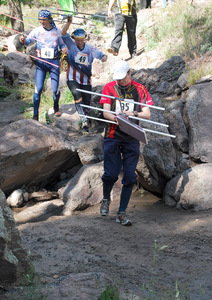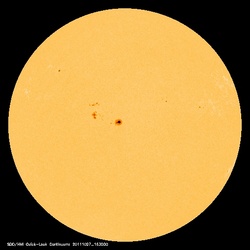 October 27, 2011 John E. Ross, KD8IDJ, Editor
| ||||||||||
+ Available on ARRL Audio News. + BPL: FCC Tightens BPL Interference Rules -- But Not By Enough On October 24, 2011, the FCC released the Second Report and Order in its proceeding -- now in its 9th year -- to adopt rules for Access Broadband over Power Line (BPL) systems. The Second Report and Order is the final step in the Commission's effort to comply with the directives of the United States Court of Appeals for the District of Columbia Circuit, which in April 2008 ordered the FCC to correct errors it had committed in the course of adopting rules in 2004. The Court acted in response to a Petition for Review filed by the ARRL.
In July 2009, the FCC issued a Request for Further Comment and Further Notice of Proposed Rule Making in which it proposed slight modification of measurement standards for determining whether a BPL system is in compliance with the maximum allowable levels of radiated emissions. In response, the ARRL argued that coupled with a scientifically valid extrapolation factor for determining those levels, mandatory notching of the amateur bands to a level 35 dB below the general emission limit would reduce the likelihood of harmful interference to amateur stations to a level that would permit any remaining harmful interference to be remedied on a case-by-case basis. The ARRL noted that its request for mandatory notching simply reflected the best practices of the BPL industry. In the Second Report and Order, the Commission decided not to adopt its own proposal and also declined to adopt the ARRL's request for mandatory notching. Instead, the Commission has increased the requirement for BPL systems to be able to notch frequency bands to at least 25 dB, an increase of 5 dB from the existing requirement of 20 dB. The Commission also made technical adjustments to its rules for determining the distance between a power line and a measurement antenna and for determining site-specific extrapolation factors. Read more here. + On the Air: 2011 ARRL CW Sweepstakes -- Are You Ready?
Steeped in tradition and still as exciting as ever, the 78th Annual ARRL Sweepstakes offers US and Canadian operators a fun-filled contest opportunity again this fall. First up is CW Sweepstakes during the weekend of November 5-7. "Last year's CW Sweepstakes provided some great activity with a number of new regional and divisional records," said ARRL Sweepstakes Contest Manager Larry Hammel, K5OT. "But you don't have to have a huge station with large antennas to have fun in Sweepstakes. Maybe you have 100 W and a backyard dipole or vertical. Or perhaps the challenge of a 5 W QRP effort hits your hot button this year. You will be amazed at the number of stations you can work as you trade exchanges all over the continent." ICOM is the Principal Awards Sponsor for the ARRL November Sweepstakes. Read more here. + ARDF Update: New Mexico Hosts Successful Foxhunting Championships
Results of the USA's 11th national championships of Amateur Radio Direction Finding (ARDF) are in the record books. Members of Albuquerque Amateur Radio Club went all out to provide a top-notch experience for fans of on-foot transmitter hunting, also called radio-orienteering and foxtailing. They came from 10 states and four other nations to see who would win medals by finding transmitters in the forests of central and northern New Mexico. From September 14-18, competitors took to the woods with directional antennas and receivers. They navigated not with GPS sets, but with maps and compasses. Their goal was to find all of their required transmitters and to get to the finish line in the shortest elapsed time. For fairness, the organizers didn't disclose the exact sites of the competition in advance. That kept anyone from doing advance reconnaissance in person or via Google Earth. Competitors boarded buses on Saturday and Sunday mornings, not knowing where there were going. Read more here. + DXCC Desk Offers Special "Paper Application Offer" for ST0R QSLs
DXers around the world are now receiving QSL cards for the 2011 ST0R operation from the new DXCC entity of South Sudan. With next year's publishing deadline for 2011 results fast approaching on December 31, 2011, the ARRL DXCC Desk is offering a special reduced price option for those DXCC participants who have already made at least one application during 2011. To take advantage of this offer, you must have already made a submission in the 2011 calendar year via either Logbook of The World (LoTW) or via a traditional paper application. If you have already made an application in 2011, you may then submit a paper ST0R QSL (no other cards -- just the ST0R South Sudan card) following these rules:
This special offer expires on December 31, 2011 and will not be extended into 2012. If you have any questions concerning these procedures, please contact ARRL Awards Branch Manager Bill Moore, NC1L, via e-mail. + ARRL Webinar Scheduled for November 3: Hams, Emergencies and the News
ARES® and emergency groups have had their hands full in the past months. Time and time again, Amateur Radio has been called upon to provide emergency communications. In some places, the hams made the news and were highly praised, while in other places, the community never knew they were there because no one worked with the news media. On November 3, The ARRL's national Public Relations Committee will present a 90 minute webinar -- Hams, Emergencies and the News. Read more here. ARES®/NTS Study: ECAC Submits Interim Report
ARES® and the National Traffic System (NTS) exist as the League's implementation of the basic principle stated in Part 97.1(a): "Recognition and enhancement of the value of the Amateur Service to the public as a voluntary non-commercial communication service, particularly with respect to providing emergency communications.' The ARRL Board of Directors' Programs and Services Committee (PSC) tasked the League's Emergency Communications Advisory Committee (ECAC) to recommend improvements to ARES® and NTS so that the Amateur Service can better serve the public in providing emergency communications. Assigned study topics include, but are not limited to, ARES® and NTS objectives and organizational structures, integration between ARES® and NTS, training, certification, and credentialing, and relationships with served agencies. Read more here. Now You Know: The National Traffic System The American Radio Relay League was founded in 1914 because Hiram Percy Maxim could not get a message via wireless from Hartford, Connecticut to Springfield, Massachusetts -- a distance of only about 30 miles. He had to rely on another wireless operator in Agawam, Massachusetts to relay his message to its intended recipient. This was the very beginning of what is now the National Traffic System (NTS). But what is the NTS? The Public Service Communications Manual defines the NTS as "a structure that allows for rapid movement of message traffic from origin to destination and training amateur operators to handle written traffic and participate in directed nets. These two objectives are the underlying foundations of the NTS. It's a system that operates daily, even continuously, with advanced digital links."
The NTS consists of operators who usually participate for one or two periods a week, and some who are active daily. The National Traffic System is an organized effort to handle traffic in accordance with a plan that is easily understood, and employs modern methods of network traffic handling. The NTS is not intended as a deterrent or competition for the many independently organized traffic networks. When necessitated by overload or lack of outlet for traffic, the facilities of such networks can function as alternate traffic routings where this is indicated in the best interest of efficient message relay and/or delivery. One of the most important features of NTS is the system concept. No NTS net is an independent entity that can conduct its activities without concern for or consideration of other NTS nets. Each net performs its function and only its function in the overall organization. If nets fail to perform their functions or perform functions intended for other nets, the overall system may be adversely affected. Nets may sometimes find it necessary to adopt temporary measures to ensure the movement of traffic. According to ARES® E-Letter Editor Rick Palm, K1CE, the best way to get to know the National Traffic System is to hook up with a local NTS traffic net in your area where messages (Radiograms) are entered and others are accepted for delivery by mail or phone. Local clubs, repeater groups and ARES operators are all good sources for local info on NTS activity. + FCC, FEMA, NOAA to Conduct First Nationwide Test of Emergency Alert System
The FCC, in coordination with the Federal Emergency Management Agency and the National Oceanic and Atmospheric Administration, will conduct the first nationwide test of the Emergency Alert System (EAS) at 2 PM EST (1900 UTC) Wednesday, November 9. According to FEMA, EAS participants -- broadcasters, satellite and digital radio and television providers, and cable and wireline video providers -- "provide a critical public service to the nation as the resilient backbone of alert and warning when all other means of communication are unavailable." Read more here. Solar Update
Tad "There has to be an invisible Sun" Cook, K7RA, reports: On Friday, October 21, the daily sunspot number broke another record for Solar Cycle 24 when it rose to 207. You have to look back to November 26, 2003 when it was two points higher - 209 -- to find a number at least as high. Last Thursday, the daily sunspot number was 195, another record until the following day. The average daily sunspot number for the week was off by two points to 156.6, while the average daily solar flux rose nearly 8 points to 151.8. Propagation on HF is quite exciting right now, with 10 meters opening up worldwide daily. The predicted solar flux is 130 on October 27-29, 125 on October 30-November 3, 120 on November 4-5, and then 125 and 130 for November 6-7 and 135 on November 8-10. Flux values for the near term are expected to peak at 165 on November 17-18. The predicted planetary A index is 5, 7, 8 and 10 on October 27-30 and 5 on October 31-November 3, 8 on November 4-5 and 5 on November 6-10. Geophysical Institute Prague predicts quiet to unsettled conditions October 28, unsettled October 29, quiet to unsettled October 30 and quiet October 31 through November 3. Look for more information on the ARRL website on Friday, October 28. For more information concerning radio propagation, visit the ARRL Technical Information Service Propagation page. This week's "Tad Cookism" is brought to you by The Police's Invisible Sun. + Silent Key: Former ARRL Midwest Division Vice Director C. Richard Dyas, W0JCP Former Midwest Division Vice Director C. Richard Dyas, W0JCP, of Oxford, Nebraska, passed away October 17. He was 90. Dyas -- a Charter ARRL Life Member -- was first elected Vice Director in 1975 and began his term on January 1, 1976. He resigned in 1985 to take care of his wife. In 1987, when then-ARRL Midwest Division Vice Director Richard Ridenour, KB0ZL, resigned, then-ARRL President Larry Price, W4RA, appointed Dyas to serve Ridenour's unexpired term. Dyas was laid to rest on October 21 with military honors by Oxford American Legion Post 219 in conjunction with the US Army National Guard Military Honors Team. This Week on the Radio This week:
Next week:
All dates, unless otherwise stated, are UTC. See the ARRL Contest Branch page, the ARRL Contest Update and the WA7BNM Contest Calendar for more information. Looking for a Special Event station? Be sure to check out the ARRL Special Event Stations Web page. Upcoming ARRL Section, State and Division Conventions and Events
To find a convention or hamfest near you, click here. ARRL -- Your One-Stop Resource for Amateur Radio News and Information Join or Renew Today! ARRL membership includes QST, Amateur Radio's most popular and informative journal, delivered to your mailbox each month. Subscribe to NCJ -- the National Contest Journal. Published bi-monthly, features articles by top contesters, letters, hints, statistics, scores, NA Sprint and QSO Parties. Subscribe to QEX -- A Forum for Communications Experimenters. Published bi-monthly, features technical articles, construction projects, columns and other items of interest to radio amateurs and communications professionals. Free of charge to ARRL members: Subscribe to the ARES E-Letter (monthly public service and emergency communications news), the ARRL Contest Update (bi-weekly contest newsletter), Division and Section news alerts -- and much more! Find us on Facebook. Follow us on Twitter. ARRL offers a wide array of products to enhance your enjoyment of Amateur Radio Donate to the fund of your choice -- support programs not funded by member dues! Click here to advertise in this newsletter. | ||||||||||

















